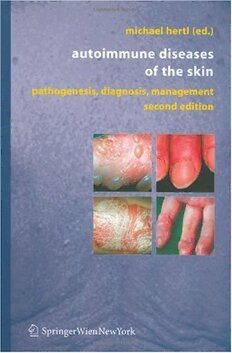
Autoimmune Diseases of the Skin Pathogenesis, Diagnosis, Management PDF
Preview Autoimmune Diseases of the Skin Pathogenesis, Diagnosis, Management
Michael Hertl (ed.) Autoimmune Diseases of the Skin Pathogenesis, Diagnosis, Management Second, revised and enlarged edition SpringerWienNewYork Prof. Michael Hertl, MD Department of Dermatology and Allergology, Philipps University, Marburg, Germany This book was supported byGesellschaft für Autoimmun-Krankheiten e.V., Schönkirchen bei Kiel This work is subject to copyright. Allrightsarereserved,whetherthewholeorpartofthematerialisconcerned,specifically thoseoftranslation,reprinting,re-useofillustrations,broadcasting,reproductionbyphoto- copying machines or similar means, and storage in data banks. © 2001 and2005 Springer-Verlag Wien · Printed in Austria SpringerWienNewYork is a part of Springer Science + Business Media springeronline.com ProductLiability:Thepublishercangivenoguaranteeforalltheinformationcontained inthisbook.Thisalsoreferstothatondrugdosageandapplicationthereof.Ineachindi- vidualcasetherespectiveusermustchecktheaccuracyoftheinformationgivenbycon- sultingotherpharmaceuticalliterature.Theuseofregisterednames,trademarks,etc. inthispublicationdoesnotimply,evenintheabsenceofaspecificstatement,thatsuch namesareexemptfromtherelevantprotectivelawsandregulationsandthereforefreefor general use. Cover illustration: M. Hertl Typesetting: Composition & Design Services, Minsk 220027, Belarus Printing: Druckerei Theiss GmbH, A-9431 St. Stefan im Lavanttal Printed on acid-free and chlorine-free bleached paper SPIN: 10975923 With 77 partly coloured Figures Library of Congress Control Number: 2005920465 ISBN 3-211-20686-8 SpringerWienNewYork ISBN 3-211-83598-9 1stedition SpringerWienNewYork Foreword Basedonrecentadvancesintheunderstandingoftheimmunologicalpatho- genesisofmanychronicinflammatorydisordersthereisincreasingevidence thatseveralofthemarecharacterizedandpotentiallymediatedbyautoimmune phenomena.Classicalexamplesarerheumatoidarthritis,myastheniagravis, pemphigusvulgaris,lupuserythematosusandmultiplesclerosis.Others,such aspsoriasisvulgaris,somelesswell-characterizedcollagenvasculardisorders, vasculitidesandasubtypeofchronicurticariahaveamoreorlesspronounced autoimmunebackgroundthathastobeconsideredintheoverallmanagement ofthesedisorders.Asignificantportionofautoimmunediseasesprecipitate primarilyorsecondarilyattheskin.Understandingthecutaneoussymptoms maybethereforecrucialforthediagnosis,classificationandtherapeuticman- agement of organ-specific and systemic disorders that require special atten- tionbythephysician. Thisbookissetouttopresentthemostrecentscientificandclinicallyrel- evantstate-of-the-art-knowledgeonthebroadspectrumofautoimmunedis- ordersaffectingtheskin.Itismeanttoprovidethemostrecentinformation onthesedisordersforcliniciansaswellaspracticionersindermatology,medi- cine,rheumatology,ENT,pediatrics,ophthalmology,orthopedicsetcandfor basicscientistsinterestedinhumanautoimmunity.Eachbookchapterdealing withadistinctcutaneousautoimmmunedisorderconsistsofanintroduction focusingonthestateofknowledgeregardingpathogenesisandepidemiology followedbyapracticalguidehowtoidentifyandhandletheparticulardisor- der(s). Special attention is paid to genuine cutaneous autoimmune disorders suchasautoimmunebullousskindisordersincludingpemphigus,pemphigoid andepidermolysisbullosaacquisita.Thesedisorderscanbeconsideredas paradigmsoforgan-specificautoimmunedisordersbecauseautoantigensand autoantibody-mediated pathogenesis are well-characterized. Majorprogresshasbeenmadeinthediagnosisandclassificationofcolla- genvasculardisorderssuchassystemicsclerosis,lupuserythematosus,dermato- myositisandoverlapsyndromes.Theseadvanceshaveprovidedthebasisfor more specific therapeutic interventions. Recent pathogenetic findings in psoriasis, lichen planus and chronic urticaria have led to novel therapeutic conceptsthatwillreplacethe“classical”symptomatictreatmentsthathave been established for decades. One striking example is the therapeutic ef- fect of biologics in severe psoriasis vulgaris and psoriatic arthritis and the VI Foreword modulatoryeffectofhighdoseimmunoglobulinsindermatomyositisandse- verevasculitides.Inadditiontothebookchaptersondistinctclinicalcutaneous disorders,theintroductorychapterexplainsbasicimmunologicalprinciples leadingtoautoimmunityandthefinalchaptergivesanoverviewofthemode ofactionofnovelimmunomodulatorydrugs.Thepresentbookwhichised- itedbymyco-workerDr.MichaelHertlissetouttocombinemajorscientific advancesintheunderstandingofautoimmunitywiththeclinicalpresentation and management of these disorders. I am convinced that the book consti- tutesaverysuccessfulefforttoprovideahandbookforthosewhoarescien- tifically or clinically interested in autoimmune disorders of the skin. I wish the editor and the authors success with this endeavor. Erlangen,July2001 GeroldSchuler Preface to the First Edition Hundredyearsago,PaulEhrlichspeculatedwhetheranindividualisableto producetoxicautoantibodiesandabouttheimplicationsofsuchantibodiesfor disease. The contention that an alteration of the body fluids causes disease followedthetraditionalteachingsofHipppocratesandGalenthatdiseasere- sultsfromdysfunctionofthefourhumors.However,Ehrlichintroducedthe novelconceptofantigenspecificitythatwasbasedonhissidechaintheoryof antibodyformation:(1)antibodiesarenaturallyoccuringsubstancesthatserve asreceptorsonthecellsurface;(2)thespecificityofantibodyforantigenis determinedbyauniquestereochemicalconfigurationofatomsthatpermits theantibodytobindtightlyandchemicallytoitsappropriateantigen;(3)the numberofdifferentcombiningsitesstructuresavailableissogreatthateach onediffersfromtheothers,withlittleornocrossreactivityamongthem;(4) andinordertoinduceactiveantibodyformation,itisonlynecessarythatap- propriatereceptorsbepresentonthecellsforantigentointeractwiththem andsostimulatetheiroverproductionandliberationintotheblood.According tothisdescriptionbyPaulEhrlich,theantibodyap-pearedtobeapolymor- phouscytoplasmicagentwithauniquefeature–ahighlyorganizedcombin- ingsite(thehaptophoregroup)thatdetermineditsuniqueantigenspecificity. ItwasBordetwhoshowedthatanti-erythrocyteantibodieswerecapable of mediating immune hemolysis giving rise to the idea that self-produced hemolytic antibodies might assist in destroying autologous erythrocytes. Thisandsimilarfindingsincludingthedescriptionofcytotoxicantibodies againstavarietyofothercelltypespromptedEhrlichtosay:“…theorgan- ismpossessescertaincontrivancesbymeansofwhichtheimmunityreaction, soeasilyproducedbyallkindsofcells,ispreventedfromactingagainstthe organism’sownelementsandsogivingrisetoautotoxins…sothatwemight bejustifiedinspeakingofa‘horrorautotoxicus’oftheorganism.Thesecon- trivancesarenaturallyofthehighestimportancefortheindividual”(P.Ehrlich and J. Morgenroth, Berlin. Klin. Wochenschr., 1901). When Metalnikov was the first to demonstrate the generation of auto- antibodiesthatwerecytotoxicagainstspermatozoainvitro,Ehrlichquestioned that they were able to induce pathologyin vivo. Ittook,however,morethanfourtyyearsthatsomedistinctorgan-specificim- munedisorderswerecategorizedastrueautoimmunediseases.Amongthefirst identifiedwereautoimmuneorchitis,allergicencephalomyelitis,autoimmune VIII Michael Hertl thyroiditis,pemphigusvulgarisandbullouspemphigoid.Noteworthy,some ofthesedisordersareexclusivelymediatedbycirculatingautoantibodiessuch as the hemolytic anemias, thrombocytopenia, pemphigus, and pemphigoid whileothers,suchasallergicautoimmuneencephalomyelitisandautoimmune thyroiditisrequirethetransferofimmunocompetentcellsinadditiontoauto- antibodies. Theexistenceofimmunologicaltolerancewasthelogicalconsequenceof PaulEhrlich’s postulatethattherewasa“horrorautotoxicus”amechanism thatinhibitedformationofpotentiallyharmfulautoantibodiestoselfinvivo. ItwasOwentoshowthatdizygoticcalveswhosecirculationwasconnected inuterowereunabletorespondtoeachother’santigensafterbirth.Outofthis andsimilarobservations,theclonaldeletiontheorywasinventedbyBurnet meaningthatantigenpresentduringembryoniclifewouldsomehowcause destructionofself-reactiveclones.Theobservationthatadultanimalscould berenderedunresponsivetoforeignantigensbytheadministrationoflarge dosesoftheantigenledtothenotionthatimmunologicaltolerancecouldbe also acquired. Therecognitionofdifferentcentralandperipheralimmunemechanisms leadingtoimmunologicaltoleranceareallbasedonEhrlich’sconceptof“hor- rorautotoxicus”,i.e.acquiredoractiveimmuneregulationofunwantedim- muneresponsesagainstself.ThefindingthatBlymphocytesgenerallyrequire thehelpofTlymphocytesintheirantibodyresponsetoadefinedantigenic stimulusledtothediscoveryofdistinctimmunecellsubsetsincludinghelper cells,cytotoxiccellsandregulatorycells.Theidentificationoftheidiotype- antiidiotypenetworkwasbornoutofthediscoverythattheantigenbinding siteoftheantibodyitsselfcanactasanantigenforanti-idiotypicantibodies. Anti-idiotypic immuneresponses arepartofthephysiological immunesur- veillance aimed at limiting the extent of an immune response. Theidentificationofdifferentlineagesofantigenpresentingcellshastaken awaymuchattentionfromTlymphocytesastheexclusiveregulatorsofimmune andautoimmuneresponses.Majorinteresthasrecentlyfocusedondendritic cells,bonemarrow-derivedantigenpresentingcellswithpotentcapacityto induceprimaryT-cell-mediatedimmuneresponses.However,accumulating evidence has demonstrated that the dendritic cell system bears much more plasticitythanoriginallythought.Dendriticcellscanarisefromseveraldiffer- enttypesofprogenitorcellsanddifferentfunctionaltypesofdendriticcells canbegeneratedfromthesameprecursor.Itthusappearsthatdendriticcells havethepotentialtomodulateimmuneresponseswithinthewidespectrum ofimmunityontheonehandandimmunologicaltoleranceontheotherhand. Therapiddevelopmentofimmunologicalresearchhasalsoprovidedma- jorinsightsinthepathogenesisofautoimmunedisorderswhichhasimplica- tions for classification, diagnosis and therapy of these disorders. Classical examplesforwell-characterizedautoimmunedisordersaremyastheniagra- vis,pemphigusvulgaris,andhemolyticanemia.Furthermore,theavailabil- ity of recombinant forms of the major autoantigens of these disorders has Preface to the First Edition IX providedcriticaltoolstoinvestigateautoimmunityversusimmunologicaltol- erance to these self proteins in affected patients and healthy individuals. Theincreasingunderstandingofthemechanismsthatleadtoimmunologi- caltolerancetoselfandtherolethatHLAandnon-HLAallelesplayinantigen recognitionbyautoaggressiveTcellsmayalsoleadtonoveltherapeuticstrat- egies.Severalclinicalstudieshavesoughttorestoreimmunologicaltolerance toselfbytheadministrationofmodifiedselfpeptides,suchastheadministra- tionofalteredpeptideligandsofmyelinproteinsinmultiplesclerosis.Immature dendriticcellsholdgreatpromiseashighlyefficienttoolstoinduceimmuno- logicaltolerancetodefinedselfproteinsorpeptidesasdemonstratedinmurine allograftrejectionmodels.Theymayinducetolerancebyinducingantigen- specificanergyofautoreactiveTcellsand/orbytheinductionofregulatory T lymphocytes that inhibit the activation of autoaggressive T cells. Iamverygratefulthatinternationallyleadingexpertsinthefieldofcuta- neous autoimmune disorders spontaneously agreed to provide comprehen- siveandwell-illustratedoverviewsofthemajorautoimmunedisordersofthe skin.Itwastrulyfuntointeractwithallofthem!Inaddition,Iwouldliketo acknowledgethesupportandeffortsofSpringerVerlaginmakingthiskind ofbookpossible.Wehopethattheconceptofthisbookwillindeedhelpto broadentheunderstandingofcutaneousautoimmunedisordersforthosework- ing in the many clinical disciplines which are involved in the care of these patients.Finally,Ithankmywifeforhercontinoussupportandherhelpand criticism during the development of this book. Erlangen,July2001 MichaelHertl Preface to the Second Edition Thankstothepositivereceptionofthefirsteditionofthebookbythemedi- calcommunitybothinEuropeandintheUSA,thepresentbookhascometo its second edition. All the chapters have been thoroughly revised and two new chapters onVitiligoandAlopecia areatawere included. Wehopethatthepresentbookwillcontinuetoprovidestate-of-the-art knowledgeforthosewhoareinterestedandclinicallyinvolvedwithautoim- mune disorders of the skin. The present edition of the book is dedicated to my clinical teacher, Pro- fessor Gerd-Klaus Steigleder, on the occasion of his 80th birthday. Marburg,January2005 MichaelHertl Contents List of Contributors..................................................................................................................XIII 1 Pathogenesis of Autoimmune Disease (Martin Röcken and Tilo Biedermann)........... 1 2 Epidemiology of Autoimmune Skin Disorders (Berthold Rzany and Niels Weller).............................................................................................................. 25 3 Autoimmune Bullous Skin Disorders 3.1 Pemphigus (Michael Hertl)..................................................................................... 45 3.2 Bullous Pemphigoid: Clinical Features, Diagnostic Markers, and Immunopathogenic Mechanisms (Emmanuel Laffitte and Luca Borradori)......................................................................................................... 71 3.3 Dermatitis Herpetiformis Duhring (Christian Rose and Detlef Zillikens)............ 95 3.4 Epidermolysis Bullosa Acquisita (Mei Chen, Dafna Hallel-Halevy, Celina Nadelman and David T. Woodley)............................................................. 109 4 Scleroderma 4.1 Localized Scleroderma (Catherine H. Orteu and Jan P. Dutz)............................. 133 4.2 Progressive Systemic Scleroderma (Nicolas Hunzelmann and Thomas Krieg).......................................................................................................... 165 5 Lupus Erythematosus 5.1 Chronic Cutaneous Lupus Erythematosus (Michael Sticherling)........................ 183 5.2 Subacute Cutaneous and Systemic Lupus Erythematosus (Donna M. Pellowski, Jane E. Kihslinger and Richard D. Sontheimer)................ 203 6 Dermatomyositis (Jeffrey P. Callen)................................................................................ 229 7 Mixed Connective Tissue Disease (Reiji Kasukawa)..................................................... 245 8 Sjogren’s Syndrome (Robert I. Fox and Ichiro Saito)..................................................... 261 9 Psoriasis Vulgaris and Arthopathica (Jörg Christoph Prinz)......................................... 291 10 Chronic Urticaria as an Autoimmune Disease (Michihiro Hide and Malcolm W. Greaves)....................................................................................................... 309 11 Lichen Planus, Lichenoid Eruptions and Cutaneous Graft-Versus-Host-Reaction (Miklós Simon Jr.)............................................................. 333 12 Small Vessel Vasculitides (Peter Lamprecht and Wolfgang L. Gross).......................... 349 XII Contents 13 Vitiligo (Karin U. Schallreuter) ...................................................................................... 367 14 Alopecia areata (Pia Freyschmidt-Paul, Kevin McElwee and Rolf Hoffmann)............. 385 15 Novel Therapeutic Approaches in Autoimmune Skin Disorders (Sybille Thoma-Uszynski and Rüdiger Eming)............................................................... 421 Subject Index........................................................................................................................... 457
